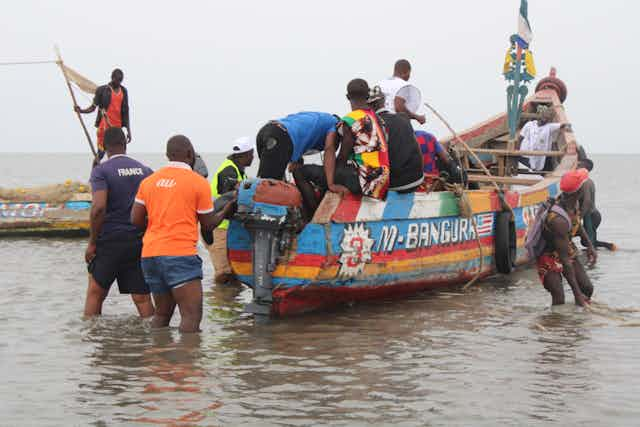In Sierra Leone almost 59% of the population live in remote, rural areas. Roads may be non-existent or in bad condition, making it very difficult for rural dwellers to access healthcare. This is one of the key reasons why COVID-19 vaccination rates in the country are low.
During an innovative vaccine programme mobile vaccine clinics were dispatched to the furthest parts of the country, sometimes on motorcycles and boats. The results showed COVID-19 vaccination rates tripled in three days.
Development Economist Niccolò F. Meriggi tells Nadine Dreyer about the programme’s potential to become a blueprint for future healthcare delivery in the country and other remote regions in Africa.
Why are vaccination rates low in Sierra Leone?
By 10 March 2022, more than a year after COVID-19 vaccines arrived on the market, 80% of people living in high-income countries had received at least one dose. In stark contrast, only 15% of people had been vaccinated in low-income countries.
Fast-forward to November 2023 and still only 33% of the population in Africa had received at least their first dose of a COVID-19 vaccine.
The hardships Sierra Leoneans face are typical of the obstacles people in low-income countries have to overcome to access healthcare.
In the early days of the COVID-19 vaccination campaign in Sierra Leone, it took the average Sierra Leonean living in a rural community three-and-a-half hours each way to the nearest vaccination centre.
Things improved as more clinics started offering the vaccine, but the cost of reaching clinics remained high and, in many cases, prohibitive. In Sierra Leone 60% of the rural population live on less than US$1.25 a day. Getting to a clinic would cost more than one week’s wages.

How did this vaccine drive tackle the problem?
A team of researchers designed a COVID-19 vaccination drive that was implemented in March and April 2022 by the Ministry of Health and Sanitation and their technical partner Concern World Wide, an international humanitarian agency.
The primary aim of this intervention was to take vaccine doses and nurses to administer vaccines to remote, rural communities, preceded by seeking permission and community mobilisation.
At the time, only 6% to 9% of the adults who took part in the programme were already immunised.
Just over 20,000 Sierra Leoneans, living in 150 rural towns outside the country’s national clinic network, took part in the vaccination campaign.
The first step was to approach village leaders including the chief and the mammy queen, the most important woman in the village. Youth and religious leaders were also consulted. They were briefed about the purpose of the visit and the vaccination team answered questions about the available vaccines.
The leaders were asked for their cooperation in encouraging eligible community members to take the COVID-19 vaccine.
That evening, when labourers returned home from farms, the health team talked directly to all villagers about vaccine efficacy and safety and the importance of getting vaccinated. They also addressed villagers’ questions and concerns.
Finally, vaccine doses and healthcare workers arrived at the villages to administer the doses. Some travelled on motorbikes or on boats because of the lack of any road access.
This last-mile vaccine intervention tripled vaccination rates within three days in treated communities.

Large numbers of people from neighbouring communities also showed up to receive vaccines at the temporary vaccination sites.
Looking forward
These results suggest that people who live far from clinics are less likely to seek healthcare and that last mile delivery is a cost-effective intervention capable of overcoming that problem.
The intervention cost in this campaign was US$33 per person vaccinated. This approach proved 76% more cost-effective than other vaccination campaigns.
Transport accounted for a large share of the costs, so the cost-effectiveness of last mile delivery can be increased by offering a “bundle” of health products. The bundle could include routine child immunisation, as well as human papillomavirus and malaria vaccines, combined with other important health supplies such as deworming tablets, vitamin A supplements, oral rehydration solutions and chlorine for drinking water.
The World Health Organization reported that between 2020 and 2021, 5.42 million people died of COVID-19.
Other estimates put the death toll for the same period at 14.83 million, which is 2.74 times higher.
Developing cost-effective strategies to make vaccines easily accessible to everyone, everywhere, is the most promising solution to prevent future pandemics. This blueprint could also be used to address obstacles to other life-saving medical care.
The research team has since been awarded funds from the International Growth Centre and the Social Science Research Council through its Mercury Project. These grants will be used to expand the model in this paper to a bundle of health products and services, including additional vaccines (HPV and Malaria) and maternal and child health interventions, and further explore its feasibility and cost-effectiveness

